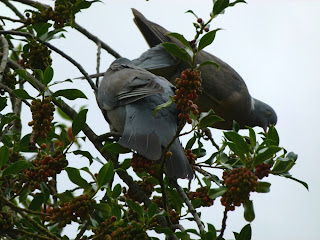Tuesday, 18 September 2012
The male Tawny Owl was calling from a tree near where the owlets were first seen this spring
-- that is, a short way north of the Albert Memorial. It remained invisible in the leaves.
While I was photographing some Long-Tailed Tits hunting insects in a tree ...
... a Chiffchaff suddenly appeared among them, and I got a couple of shots before this shy bird flew off. Of course there is a twig in front of its face, but never mind, it's the first time I have managed to photograph one.
Foraging Long-Tailed Tits accept both other small tits, such as Blue and Coal Tits, and small warblers such as Goldcrests into their flocks -- I even saw a Firecrest in a flock once. So the presence of the Chiffchaff was not extraordinary.
Some Wood Pigeons were lurching about heavily in a holly bush eating the half-ripe berries. They are not graceful birds.
In the Italian Garden, one of the three young Moorhens was strolling around on top of the wire netting, grasping it sure-footedly with its long toes.
I think that Moorhens enjoy balancing in difficult places, and I have often seen a Moorhen walking along a strand of rope with its wings outstretched for balance, looking just like a human tightrope walker.
A young man was flying a large radio-controlled aeroplane over Buck Hill. It had about the same wingspan as a Herring Gull and was white. A passing Kestrel was intrigued by this phenomenon and came over for a closer look, but soon decided that it was too large to kill and might fight back.
Update: on my attemped identification of the first-year gulls (see post for 16 September), Roy Sanderson writes:
'It really is a minefield, so many different plumages over three years, pale and dark birds ... Plumage changes between autumn and spring. Bill size and shape are seldom mentioned and head shape not at all in my books. However, the art of gull recognition is developing as more people search for the more unusual species, such as Yellow-Legged and Caspian, even the occasional American Herring Gull. Life is too short! Best criteria in my ringing guide is the inner primaries. Pale tips in Lesser Black-Backed and white tips for Herring. Head and bill measurements are 5 mm longer in Herring Gulls, but you've got to catch your bird first! There is a very active ringing group at Pitsea and Rainham, North Thames Gull Group, who are cannon-netting the gulls on a rubbish tip. They will be more conversant with the plumage variations than me. It is quite an interesting web site to visit. You may be correct in your ID, but I am really not sure.'
Subscribe to:
Post Comments (Atom)




Great photo of the Chiff-Chaff. I have never actually seen one to my knowledge, though have often heard them, so I was grateful to have a picture.
ReplyDelete